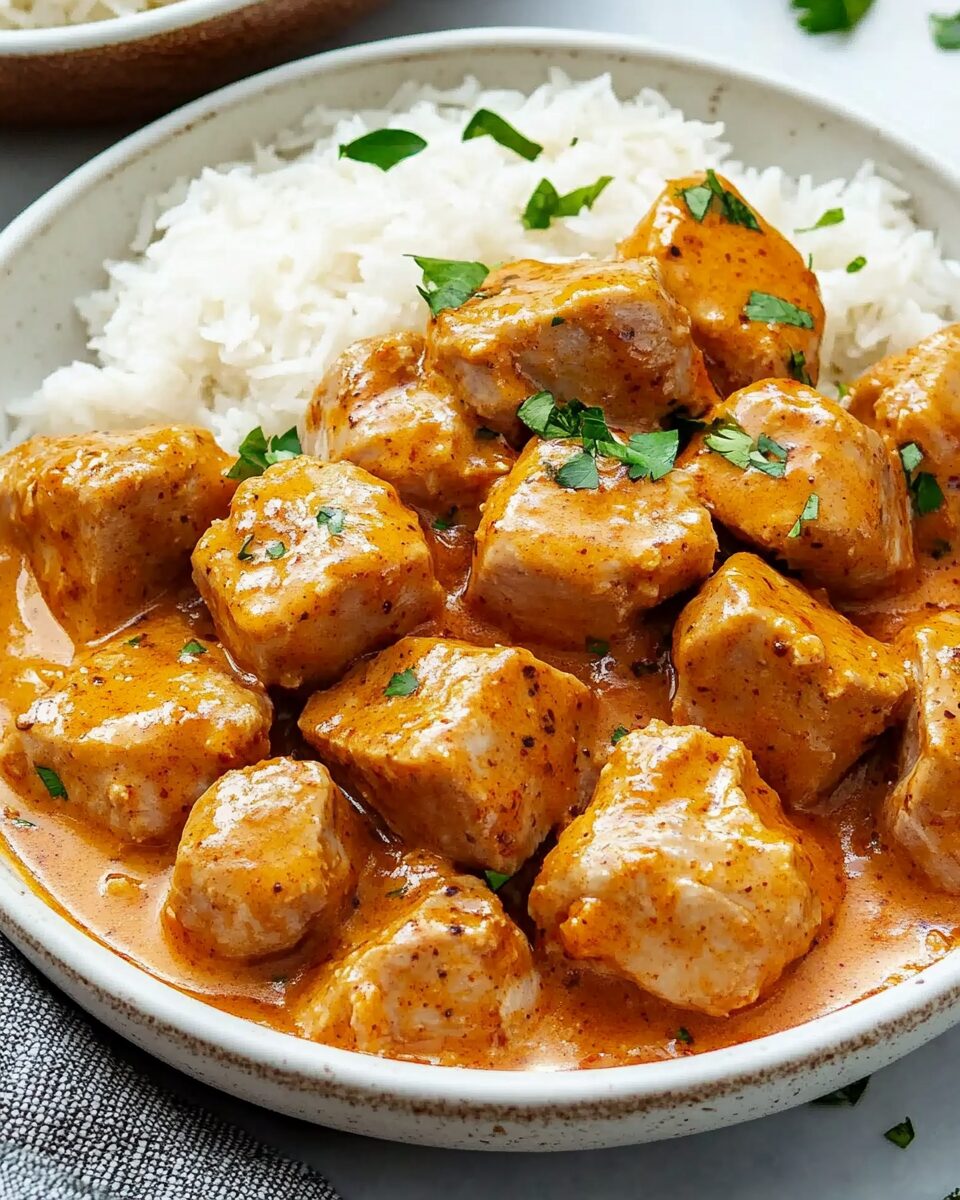Paprika Pork is a rich, smoky, and savory dish rooted in Hungarian and Central European traditions. Featuring tender pork simmered in a paprika-infused sauce, it’s quick to prepare, deeply flavorful, and perfect for weeknight dinners or special occasions. You can pair it with rice, mashed potatoes, noodles, or crusty bread, and easily adjust the spice level with sweet, smoked, or hot paprika.
Full Recipe:
Ingredients
For the Pork:
-
1.5 lbs pork tenderloin or pork shoulder, cut into cubes
-
1 tsp salt
-
½ tsp black pepper
-
1 tbsp olive oil
For the Paprika Sauce:
-
1 onion, finely chopped
-
2 cloves garlic, minced
-
1 tbsp smoked paprika (or sweet paprika for a milder flavor)
-
½ tsp cumin (optional)
-
1 tbsp tomato paste
-
½ cup chicken broth (or beef broth for richer flavor)
-
½ cup sour cream (or Greek yogurt for a lighter version)
-
1 tbsp Worcestershire sauce
For Garnish (Optional):
-
Fresh parsley, chopped
-
Extra dollop of sour cream
Directions
-
Season and Brown the Pork
-
Season pork cubes with salt and black pepper.
-
Heat olive oil in a pan over medium-high heat.
-
Sear the pork for 3–4 minutes per side until golden brown. Remove and set aside.
-
-
Make the Paprika Sauce
-
In the same pan, sauté onions and garlic for 2–3 minutes until softened.
-
Stir in smoked paprika, cumin, and tomato paste; cook for 1 minute until fragrant.
-
Pour in chicken broth and Worcestershire sauce, stirring well.
-
-
Simmer Until Tender
-
Return the browned pork to the pan and reduce heat to low.
-
Simmer for 20–25 minutes, stirring occasionally, until pork is tender.
-
Stir in sour cream at the end for a creamy finish.
-
-
Serve and Enjoy
-
Plate the pork and garnish with parsley and a dollop of sour cream if desired.
-
Serve with rice, mashed potatoes, noodles, or crusty bread.
-
Nutrients (Estimated per serving)
-
Calories: ~350–400 kcal
-
Protein: ~30g
-
Fat: ~20g
-
Carbohydrates: ~10–12g
-
Fiber: ~1–2g
-
Sodium: ~600mg
Origins and Cultural Popularity
The origins of Paprika Pork can be traced back to Hungary, where paprika is a fundamental spice in everyday cooking. Hungarian cuisine places a strong emphasis on bold, earthy flavors, with pork playing a leading role in many traditional dishes. Goulash and pörkölt are just two examples of paprika-based Hungarian stews that inspired recipes like this one. Over time, variations of this dish have spread across Central and Eastern Europe, including countries like Slovakia, Czechia, Poland, and Austria—each adding its own regional flair using different cuts of pork, types of paprika, and serving accompaniments.
What makes this dish especially popular today is its simplicity and versatility. It only requires a few pantry staples and can be made in under an hour, making it an excellent go-to recipe for busy households. The rise of global interest in comfort food and traditional European recipes has brought renewed attention to Paprika Pork, turning it from a regional specialty into an internationally beloved meal.
Why You’ll Love Paprika Pork
There are countless reasons to fall in love with Paprika Pork. First and foremost, the dish boasts an incredible depth of flavor despite its short ingredient list. The paprika sauce—made from sautéed onions, garlic, tomato paste, and either sweet or smoked paprika—develops a robust, slightly spicy profile that complements the tender pork cubes perfectly.
This recipe is also incredibly versatile. You can opt for pork tenderloin if you prefer lean cuts, or use pork shoulder for a more succulent, fall-apart texture. The sauce can be adjusted with more or less heat depending on the type of paprika used, giving you control over the flavor intensity. Additionally, sour cream or Greek yogurt stirred in at the end adds a creamy tang that balances out the smokiness beautifully.
Finally, it’s a one-pan wonder. This means minimal cleanup and maximum flavor—perfect for home cooks who want delicious results without a lot of hassle.
Health Benefits
Though hearty and indulgent in taste, Paprika Pork can be quite nutritious, especially when made with thoughtful ingredient choices. Pork tenderloin, in particular, is a lean cut of meat rich in protein, iron, and B vitamins. The inclusion of garlic and onions not only builds the base flavor but also provides immune-boosting compounds and antioxidants.
Paprika itself is a super-spice, containing capsaicin and carotenoids that are beneficial for heart health and inflammation. When combined with a moderate portion of sour cream or Greek yogurt, the sauce offers a source of healthy fats and probiotics, especially if yogurt is used. Serve the dish with fiber-rich sides like whole-grain rice or steamed vegetables for a well-balanced, nutrient-dense meal.
Serving Suggestions
Paprika Pork pairs beautifully with a variety of side dishes. For a classic take, serve it over fluffy white rice or buttered egg noodles—both absorb the creamy sauce deliciously. Mashed potatoes are another popular choice, offering a smooth, starchy base that enhances the dish’s comforting qualities. For a rustic approach, consider serving it with crusty bread to mop up every drop of the rich paprika sauce.
You can also balance out the richness of the pork by serving it with a crisp green salad or steamed seasonal vegetables like green beans, carrots, or broccoli. The freshness of the vegetables contrasts nicely with the smoky depth of the pork, making the overall meal feel lighter.
If you’re entertaining guests, consider adding a Hungarian red wine such as Kadarka or Egri Bikavér (Bull’s Blood) to the table—these wines have enough structure and spice to complement the dish perfectly.
Cooking Tips for the Best Result
To achieve maximum flavor, make sure to sear the pork well on all sides before simmering. This browning process develops fond (flavorful browned bits) in the pan, which enhances the sauce when deglazed with broth. Be mindful of the heat while cooking the paprika—adding it too early or at high heat can cause it to burn, turning bitter instead of sweet and smoky.
If you want an even thicker sauce, allow the dish to simmer uncovered for a few minutes before stirring in the sour cream. Conversely, for a silkier texture, blend a portion of the sauce with an immersion blender before returning the pork to the pan.
Don’t be afraid to experiment with the paprika type. Sweet Hungarian paprika will give you a milder flavor, while smoked paprika adds depth and a touch of fire. If you enjoy spicy food, a pinch of hot paprika or cayenne can elevate the dish further.
Common Mistakes to Avoid
One common mistake is overcooking the pork, which can make it dry and tough—especially if using tenderloin. Keep the simmer low and monitor the texture closely. Another pitfall is adding the sour cream too early or at high heat, which can cause it to curdle. Always stir it in at the end with the heat turned off or very low.
Neglecting to sauté the tomato paste with the spices is another misstep. This brief step helps to caramelize the paste and spices, intensifying their flavor and adding complexity to the final dish.
Lastly, don’t forget to season properly. Underseasoned food can taste flat, and the paprika sauce especially benefits from a well-balanced seasoning of salt and Worcestershire to bring out all its savory undertones.
Ingredient Spotlight: Paprika
The true star of this dish is paprika. Available in sweet, smoked, and hot varieties, paprika is made from ground chili peppers and is essential to Hungarian and Central European cooking. It lends not only a deep red color to the dish but also contributes earthy, sweet, and smoky tones depending on the variety.
Smoked paprika (often labeled as Spanish or Pimentón) adds a barbecue-like flavor, making the dish feel heartier and more aromatic. Sweet paprika is more subtle and accessible, perfect for those new to paprika-based dishes or those cooking for children. Hot paprika brings the heat, ideal for spice lovers looking to intensify the experience.
Similar Recipes to Try
If you enjoy Paprika Pork, you may also love exploring similar dishes such as Hungarian Goulash, Chicken Paprikash, or Beef Stroganoff. Each of these recipes shares a creamy, paprika-forward sauce and a hearty meat base, offering a warm and satisfying meal experience. For a lighter alternative, try Paprika Chicken Skillet or a vegetarian lentil version with paprika and tomatoes.
Conclusion
Paprika Pork is a deeply satisfying dish that honors the rich culinary traditions of Hungary and Central Europe while offering incredible flexibility for the modern kitchen. Its bold flavor, simple preparation, and comforting texture make it a standout recipe that’s perfect for everything from busy weeknight meals to cozy weekend gatherings. With the smoky aroma of paprika, the tenderness of seared pork, and the creaminess of the final sauce, this dish delivers comfort in every bite. Add it to your dinner rotation and experience how a humble list of ingredients can yield extraordinary results.







